wp4
Conference papers accepted: ESCIM
06/02/24/10:27 Filed in: Conference papers
I. Perfilieva, N. Madrid, M. Ojeda-Aciego, P. Artiemjew, A. Niemczynowicz. Extreme Learning Machine as a New Learning Paradigm: Pros and Cons. Eur. Symp. on Computational Intelligence and Mathematics, ESCIM, 2024.
ABSTRACT We analyze the validity of the Extreme Learning Machine principles proposed as a new learning methodology for Single Layer Feedforward Neural Networks. We show that despite the empirical success of ELM, its theoretical platform does not have a rigorous mathematical justification. To do this, we show that two main statements in its seminal paper do not have correct proofs and are in fact incorrect. Moreover, we create a dataset that provides a counterexample to the theoretical assertions done about the ELM learning algorithm.
F. Pérez-Gámez, C. Bejines, P. Cordero, D. López-Rodríguez, M. Ojeda-Hernández. Inheritance of completeness between systems of strong and weak implications. Eur. Symp. on Computational Intelligence and Mathematics, ESCIM, 2024.
ABSTRACT The study of unknown information in formal contexts can be done from two extremely different points of view: working just with the information available at the moment, or exploring all the different values that the unknown information can take.
From these two perspectives, we obtain two kinds of attribute implications: the weak ones which are the attribute implications that hold with the current amount of information, and the strong ones which will also hold under any update of the context. We study whether, given a complete system of weak implications concerning partial formal context, one can extract a complete system of strong ones concerning the same partial formal context.
D. Pérez-Medina, N. Madrid, P.A. Kowalski. Legal and technical challenges of AI in the field of Criminal investigations. Eur. Symp. on Computational Intelligence and Mathematics, ESCIM, 2024.
ABSTRACT This article addresses critical challenges in the intersection of artificial intelligence, crime investigation and digital forensics, particularly in light of the
proposed Regulation on Artificial Intelligence in the European Union. The focus is on mitigating biases caused by databases and algorithms, with real-world examples
highlighting discriminatory biases in criminal proceedings. The article emphasises the necessity of addressing biases in both data and algorithmic decision-making to
ensure fair outcomes. Another key concern explored is the lack of traceability in AI-based decisions, posing challenges to accountability and transparency, especially,
in the context of criminal investigations. Additionally, the article delves into the protection of private and family data in the vast datasets analysed by AI systems, referencing a legal case that underscores the potential violation of the right to a fair trial. To address this, the article proposes the development of anonymisation
systems to safeguard individuals’ privacy rights. The overarching theme is the need for ethical considerations and legal frameworks to guide the responsible development and deployment of AI tools in digital forensics.
ESTYLF conference organized
We have co-chaired the Spanish Fuzzy Logic and Technology conference (ESTYLF) in Coruña
The most recent edition of the Spanish Conference on Fuzzy Logic and Technology (ESTYLF) has been co-chaired by Manuel Ojeda-Aciego and Jesús Medina (from Univ. Cádiz).
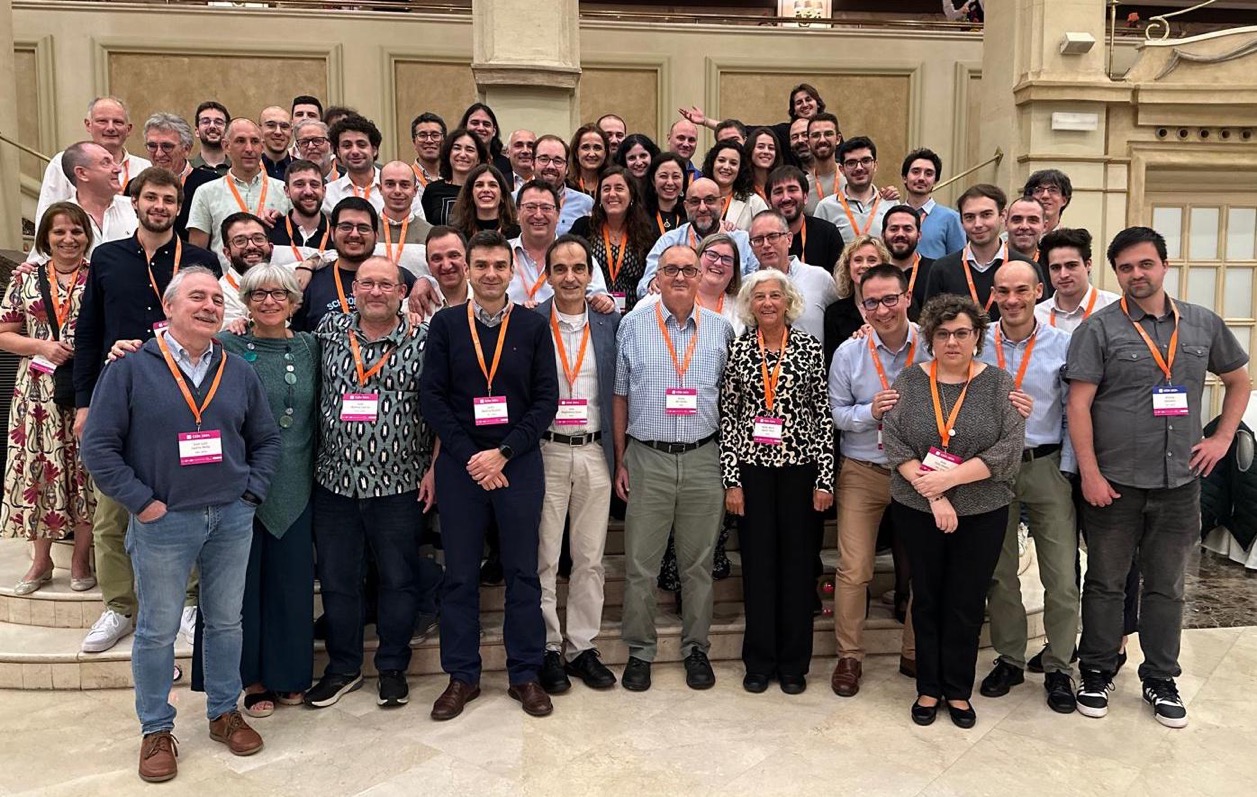
Our group presented three communications:
- F. Pérez-Gámez and C. Bejines. Álgebras de Heyting débiles: una generalización para retículos no distributivos.
- I.P. Cabrera, P. Cordero, E. Muñoz-Velasco and M. Ojeda-Hernández. Estructuras de clausura difusas como puntos fijos de conexiones de Galois.
- N. Madrid and M. Ojeda-Aciego. El f-índice de inclusión como par adjunto óptimo para modus ponens difuso.
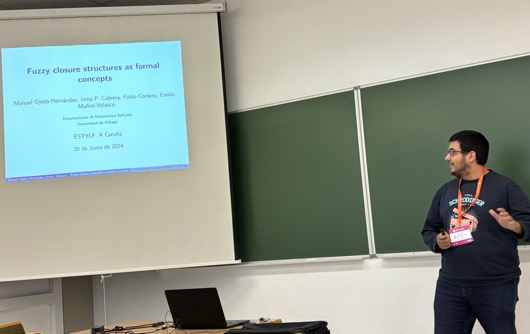
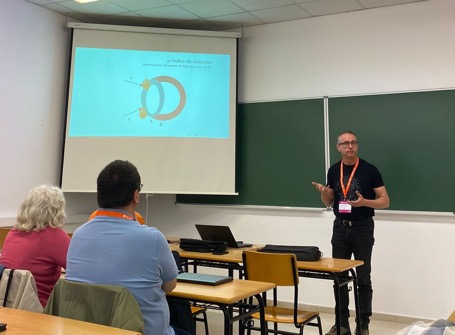
We also participated as co-editors of the proceedings of CAEPIA'24, published by Springer.
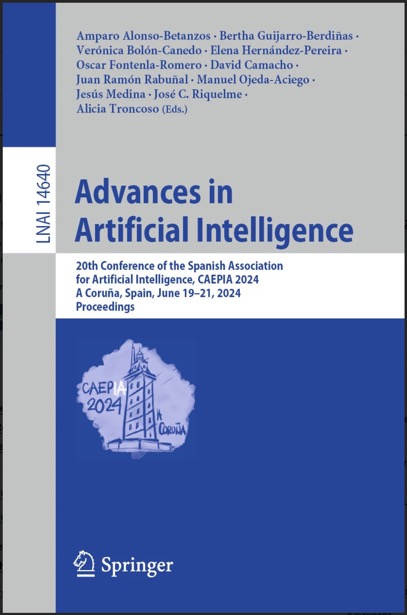
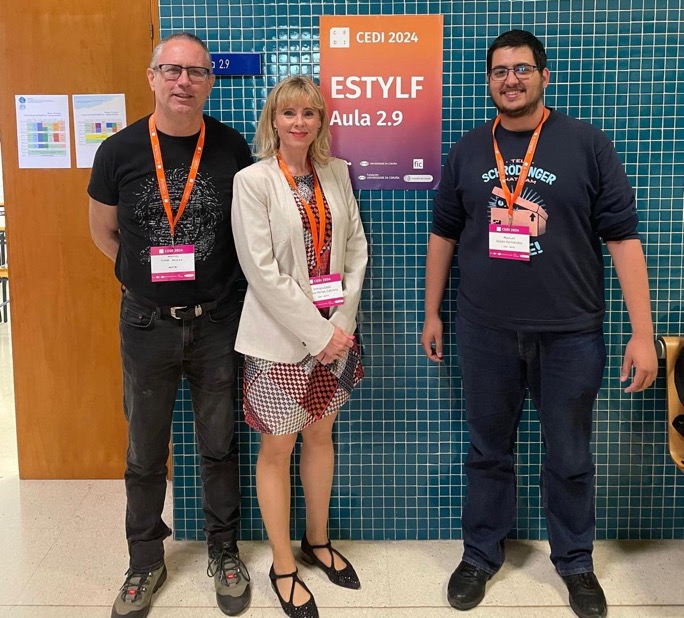
Journal papers accepted: IJAR, FSI
27/06/24/13:14 Filed in: Journal papers
F.J. Talavera, C. Bejines, S. Ardanza-Trevijano, J. Elorza. Aggregation of fuzzy graphs. Intl J of Approximate Reasoning 109243, 2024
ABSTRACT Our study is centered on the aggregation of fuzzy graphs, looking for conditions under which the aggregation process yields another fuzzy graph. We conduct an in-depth analysis of the preservation of several important properties and structures inherent to fuzzy graphs, like paths, cycles, or bridges. In addition we obtain appropriate criteria for when the aggregation of complete fuzzy graphs is again a complete fuzzy graph.
M. Ojeda-Hernández, D. López-Rodríguez, Á. Mora. A Formal Concept Analysis Approach to Hierarchical Description of Malware Threats. Forensic Science International, 2024. To appear.
ABSTRACT The problem of intelligent malware detection has become increasingly relevant in the industry, as there has been an explosion in the diversity of threats and attacks that affect not only small users, but also large organisations and governments. One of the problems in this field is the lack of homogenisation or standardisation in the nomenclature used by different antivirus programs for different malware threats. The lack of a clear definition of what a {category} is and how it relates to individual threats makes it difficult to share data and extract common information from multiple antivirus programs. Therefore, efforts to create a common naming convention and hierarchy for malware are important to improve collaboration and information sharing in this field.
Our approach uses as a tool the methods of Formal Concept Analysis (FCA) to model and attempt to solve this problem. FCA is an algebraic framework able to discover useful knowledge in the form of a concept lattice and implications relating to the detection and diagnosis of suspicious files and threats. The knowledge extracted using this mathematical tool illustrates how formal methods can help prevent new threats and attacks. We will show the results of applying the proposed methodology to the identification of hierarchical relationships between malware.
ABSTRACT Our study is centered on the aggregation of fuzzy graphs, looking for conditions under which the aggregation process yields another fuzzy graph. We conduct an in-depth analysis of the preservation of several important properties and structures inherent to fuzzy graphs, like paths, cycles, or bridges. In addition we obtain appropriate criteria for when the aggregation of complete fuzzy graphs is again a complete fuzzy graph.
M. Ojeda-Hernández, D. López-Rodríguez, Á. Mora. A Formal Concept Analysis Approach to Hierarchical Description of Malware Threats. Forensic Science International, 2024. To appear.
ABSTRACT The problem of intelligent malware detection has become increasingly relevant in the industry, as there has been an explosion in the diversity of threats and attacks that affect not only small users, but also large organisations and governments. One of the problems in this field is the lack of homogenisation or standardisation in the nomenclature used by different antivirus programs for different malware threats. The lack of a clear definition of what a {category} is and how it relates to individual threats makes it difficult to share data and extract common information from multiple antivirus programs. Therefore, efforts to create a common naming convention and hierarchy for malware are important to improve collaboration and information sharing in this field.
Our approach uses as a tool the methods of Formal Concept Analysis (FCA) to model and attempt to solve this problem. FCA is an algebraic framework able to discover useful knowledge in the form of a concept lattice and implications relating to the detection and diagnosis of suspicious files and threats. The knowledge extracted using this mathematical tool illustrates how formal methods can help prevent new threats and attacks. We will show the results of applying the proposed methodology to the identification of hierarchical relationships between malware.
Journal paper accepted: IJAR
10/03/25/10:26 Filed in: Journal paper
H.J. Bello, M. Ojeda-Hernández, D. López-Rodríguez, C. Bejines. Fuzzy time series analysis: Expanding the scope with fuzzy numbers. Int. J. of Approximate Reasoning 180:Article 109387, 2025.
ABSTRACT This article delves into the process of fuzzifying time series, which entails converting a conventional time series into a time-indexed sequence of fuzzy numbers. The focus lies on the well-established practice of fuzzifying time series when a predefined degree of uncertainty is known, employing fuzzy numbers to quantify volatility or vagueness. To address practical challenges associated with volatility or vagueness quantification, we introduce the concept of informed time series. An algorithm is proposed to derive fuzzy time series, and findings include the examination of structural breaks within the realm of fuzzy time series. Additionally, this article underscores the significance of employing topological tools in the analysis of fuzzy time series, accentuating the role of these tools in extracting insights and unraveling intricate relationships within the data.
ABSTRACT This article delves into the process of fuzzifying time series, which entails converting a conventional time series into a time-indexed sequence of fuzzy numbers. The focus lies on the well-established practice of fuzzifying time series when a predefined degree of uncertainty is known, employing fuzzy numbers to quantify volatility or vagueness. To address practical challenges associated with volatility or vagueness quantification, we introduce the concept of informed time series. An algorithm is proposed to derive fuzzy time series, and findings include the examination of structural breaks within the realm of fuzzy time series. Additionally, this article underscores the significance of employing topological tools in the analysis of fuzzy time series, accentuating the role of these tools in extracting insights and unraveling intricate relationships within the data.
Participation ACLAI'23
06/11/23/09:19 Filed in: Conference participation | Chairing
Challenges and Adequacy Conditions for Logics in the New Age of Artificial Intelligence. Málaga Nov 2-4, 2023
In this workshop, organised by the Spanish project LIANDA (BBVA Foundation), our colleague Nicolás Madrid presented his work on
"Adequacy of AI techniques for Digital Forensic tasks".
The event hosted a range of talks and discussions that include technical work on current systems of logic for AI as well as philosophical reflections on logical methodology, besides examining external desiderata for logics that arise for instance from legal or ethical requirements for AI systems.
Conference papers accepted ESTYLF
17/04/24/10:15 Filed in: Conference papers
Francisco Pérez-Gámez and Carlos Bejines. Álgebras de Heyting débiles: una generalización para retículos no distributivos. Congreso Español de Tecnología y Lógica Difusa (ESTYLF), Coruña, 2024.
ABSTRACT En este artículo se presentan las álgebras de Heyting débiles. Estas álgebras constituyen una extensión del álgebra de Heyting adaptada a retículos no distributivos. Fijado un retículo, se enumeran condiciones que garantizan la existencia de estas álgebras. Además, se caracterizan en función de los operadores de implicación y se acota su rango.
I.P. Cabrera, P. Cordero, E. Muñoz-Velasco and M. Ojeda-Hernández. Estructuras de clausura difusas como puntos fijos de conexiones de Galois. Congreso Español de Tecnología y Lógica Difusa (ESTYLF), Coruña, 2024.
ABSTRACT Las conexiones de Galois parecen estar omnipresentes en las matemáticas. Se han utilizado para modelizar soluciones de problemas tanto puros como orientados a aplicaciones. A lo largo del artículo, el marco general es un retículo completo difuso sobre un retículo residuado completo. En este trabajo, se estudia la existencia de conexiones difusas de Galois (antítonas e isótonas) entre cuatro conjuntos ordenados específicos. Lo más interesante es que los sistemas de cierre difusos, los operadores de cierre difusos y las relaciones de cierre difusas fuertes son conceptos formales (puntos fijos) de estas conexiones de Galois difusas..
N. Madrid and M. Ojeda-Aciego. El f-índice de inclusión como par adjunto óptimo para modus ponens difuso. Congreso Español de Tecnología y Lógica Difusa (ESTYLF), Coruña, 2024.
ABSTRACT Continuamos estudiando las propiedades del f-índice de inclusión y mostramos que, dado un par fijo de conjuntos difusos, su f-índice de inclusión puede vincularse a una conjunción difusa que forma parte de un par adjunto. También mostramos que, cuando este par se utiliza como estructura subyacente para proporcionar una interpretación difusa de la regla de inferencia modus ponens, proporciona el máximo valor de verdad posible en la conclusión entre todos los valores obtenidos por modus ponens difuso utilizando cualquier otro par adjunto posible.
ABSTRACT En este artículo se presentan las álgebras de Heyting débiles. Estas álgebras constituyen una extensión del álgebra de Heyting adaptada a retículos no distributivos. Fijado un retículo, se enumeran condiciones que garantizan la existencia de estas álgebras. Además, se caracterizan en función de los operadores de implicación y se acota su rango.
I.P. Cabrera, P. Cordero, E. Muñoz-Velasco and M. Ojeda-Hernández. Estructuras de clausura difusas como puntos fijos de conexiones de Galois. Congreso Español de Tecnología y Lógica Difusa (ESTYLF), Coruña, 2024.
ABSTRACT Las conexiones de Galois parecen estar omnipresentes en las matemáticas. Se han utilizado para modelizar soluciones de problemas tanto puros como orientados a aplicaciones. A lo largo del artículo, el marco general es un retículo completo difuso sobre un retículo residuado completo. En este trabajo, se estudia la existencia de conexiones difusas de Galois (antítonas e isótonas) entre cuatro conjuntos ordenados específicos. Lo más interesante es que los sistemas de cierre difusos, los operadores de cierre difusos y las relaciones de cierre difusas fuertes son conceptos formales (puntos fijos) de estas conexiones de Galois difusas..
N. Madrid and M. Ojeda-Aciego. El f-índice de inclusión como par adjunto óptimo para modus ponens difuso. Congreso Español de Tecnología y Lógica Difusa (ESTYLF), Coruña, 2024.
ABSTRACT Continuamos estudiando las propiedades del f-índice de inclusión y mostramos que, dado un par fijo de conjuntos difusos, su f-índice de inclusión puede vincularse a una conjunción difusa que forma parte de un par adjunto. También mostramos que, cuando este par se utiliza como estructura subyacente para proporcionar una interpretación difusa de la regla de inferencia modus ponens, proporciona el máximo valor de verdad posible en la conclusión entre todos los valores obtenidos por modus ponens difuso utilizando cualquier otro par adjunto posible.
